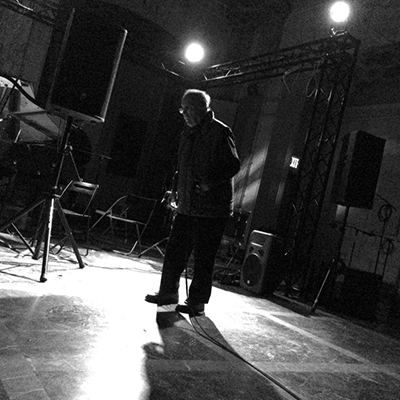|
P R E S S THEATER SCENE THE SOUND PROJECTOR CHICAGO READER NEW YORK CLASSICAL REVIEW VITAL WEEKLY PARIS TRANSATLANTIC NY MUSIC DAILY THE BIG CITY THE BIG CITY CHARLESTON CITY PAPER |
 |
|
LUCIER WORKS SPARK AN ALCHEMIST'S MAGIC WITH ENSEMBLE PAMPLEMOUSSE The history of music parallels the history of science and philosophy as a series of discoveries of an accumulation of knowledge. That makes Alvin Lucier a philosopher and a scientist. As an experimental composer, he puts his ideas to the test and because he works with sound, what he produces enters the realms of alchemy and magic. Lucier was on hand at Issue Project Room Tuesday for a concert from Ensemble Pamplemousse, one of the most distinctive new music ensembles in New York. Three of his works were on the program, which was filled out by pieces from ensemble flutist Natacha Diels and co-director Andrew Greenwald, and three welcome pieces from the contemporary Austrian composer Klaus Lang. The premiere of Diel's composition, Second Nightmare for Kiku (Kiku Enomoto, Pamplemousse's violinist) opened the concert. It's an odd work and not fully successful. There are several intriguing ideas within: a miniature concerto for violin with two "assistants" who play percussion instruments, use some electronics and vocalize; a theatrical element with the musicians posing; long tones that hint at subrosa expression. But Diels doesn't give any of thee variegated elements sufficient time to fully develop. Greenwald's excellent Softrut(C), for piccolo, violin, viola and oboe, started the second half and showed the unique virtue of Pamplemousse. It is an ensemble that improvises best, the players are sharp listeners, quick thinkers and make creative use of the full gamut of sounds from their instruments. The piece is a graphic score, and the musicians interpreted it with an exciting and involving sense of agitation. Ultimately, the night belonged to Lang and Lucier. Lang's three compositions – Geschrieben in Wasser for piano quintet, Die drei Felder im Schnee und die scharlachrote Sonne for flute and percussion and tehran dust for cello and harmonium – concluded the concert. Pamplemousse played them attacca as a suite, a wise choice. The piano quintet is disorienting, an alternating series of chords in the piano and strings, the latter mostly playing harmonics, while the piano's sustain pedal is held down. The alternation between resonance and dryness pulls in and pushes away the listener. Geschrieben in Wasser is poker-faced and puts Lang somewhere between Morton Feldman and the Wandelweiser movement. The two following pieces were something else altogether—extraordinary music that manifested Lang as a distinctive individual voice. They are each sonically mysterious, beautiful dialogues, and they made the first work better in context. Die drei Felder is antiphonal. A broken march rhythm on the drum was answered by Diels playing soft, long tones on the alto flute and singing quietly through the instrument, an utterly haunting sound. The response was pianissimo rolls on the bass drum, a single tap of the triangle, the flutist playing and stepping slowly sideways down a row of three music stands. At the end, playing the piccolo, still long and soft, she stepped into the shadows. Keyboardist David Broome then slid onto the seat in front of a harmonium for tehran dust. He slowly built triads and four-note chords, moving from one to another. After a time, cellist and ensemble co-director Jesse Marino joined in with single, sustained notes, bent slowly up and down in quarter-note de-tunings. The reedy sound of the harmonium, the grainy texture of the cello and the complex intervals that were both consonant and dissonant created a rich and plangent sound. Two Lucier pieces were built around a core of standard instruments: Music for Piano and Amplified Sonorous Vessels, piano with, in this case a teapot, a vase and a couple other objects, and December 12th for flute, violin, cello, piano and oscillators, and written for Pamplemousse." These works explore sound waves, and how the waves that notes produce can work together to create extra sounds. These are not just dry experiments—they are compositions that create gorgeous, pure tones. In the piano piece, the vibrations from the strings create resonant tones in the vessels, all combining in chords that mix natural harmonics and the colors of the objects. December 12th is one of Lucier's pieces that match musicians playing long notes against oscillators that themselves slowly and steadily move up or down in pitch. The difference tones between pitches wobble and beat against each other, their speed fluctuating in inverse proportion to their distance. The sound waves spun around the room and were reflected as faint but audible discrete notes. The experience was of being inside both the idea and realization of a composition." Lucier himself performed Bird and Person Dyning. Three loudspeakers were arrayed facing the audience while Lucier stood in back in the center aisle. An electronic birdcall was played through the speakers, and Lucier listened with a microphone hung from his neck, the cable trailing back to an amplifier which in turn played the sound through the same speakers as a feedback loop. The composer slowly moved up the aisle, tilting his head carefully in different directions, listening to the feedback and reshaping it. He made the sound sing from the speakers, eventually finding his way to stand with them, the feedback never shrieking but always shining. Towards the end, the sound held, rose a half-step, slid back down again, a real accompaniment to the bird call. Science, yes, but also alchemy, and magic. |